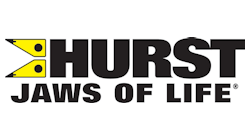Manufacturer's Corner: High-Strength Steels Inspiring Rescue Tool Design, Training
Manufacturers’ Corner content is sponsored by manufacturers and suppliers serving the fire service industry.
When it comes to the high-strength steel used by automotive manufacturers to keep passengers safe, there’s no doubt that the “car of the future” is here today. Tensile strength (MPa) has increased exponentially and designs have shifted, ensuring people are better cocooned in their automobiles than ever before. The challenge: extremely tough metal makes for very difficult rescues by first responders. What’s the solution? Knowledge, training and tools.
First, the knowledge – the “how did we get here?” and the “where do we go?” In 1975 when hydraulic rescue tools were in their early years of service, cars typically were comprised of approximately four percent high strength steel (700 MPa). By 2007, that percentage was up to 12 (1,500 MPa), providing challenges to the cutters used by first responders to extricate patients from their cars. It had been predicted that by 2020 cars would be made with 97 percent high strength steel or advanced high strength steel. However, there already are increasingly high percentages of HSS and AHSS in models made since 2011; the future is here, a few years sooner than expected.
As high elongation metals are ranging into higher tensile strength, the older cutters can struggle to cut, requiring rescue tool manufacturers to use technology and innovation to develop new tools that can face and conquer these obstacles. Last year at FDIC, HURST Jaws of Life, in partnership with Brock Archer of Advanced Extrication, showed attending firefighters how these new tools work through a live tutorial on best extrication practices on a Tesla Model X, whose frame and underbelly are made from advanced high strength steel.
These metals aren’t exclusive to high-end automobiles; they’re being seen in cars including the Buick LaCrosse and Subaru Legacy (B posts). The 2016 Honda Pilot, for example, shows 1,500 MPa in critical cut areas including but not limited to the B Post.
In the past, a cutter would wrap around the B post, pull it to crush and then cut. Now, on cars made with HSS, the cutter must immediately start cutting. It must produce much more force at wider diameters because high strength steels don’t fold; the metal will fracture because it’s so brittle. In fact, there are parts of A posts and B posts that simply cannot be cut, so first responders must be surgical in how and where they cut today’s cars. Knowing these facts and understanding where to cut on these newer model cars will ensure first responders make the right cut in the right place to get to the patient faster.
It’s this need to help educate first responders that drives HURST Jaws of Life to continually enhance its partnerships both with the manufacturers who make today’s cars as well as with the dealers, distributors and trainers who teach those who use HURST tools to save lives. In understanding the fabrication of a vehicle and then “training the trainer” and educating rescue specialists, HURST strives to help take some of the mystique away from extricating patients from the car of the future.
The tools must be able to stand up to the task, too. HURST has several models that rise to this new HSS challenge: S 700E2, S 700 and JL-500. Product development continually adapts to combat high-strength steel, such as smaller, sharper tips to allow blade tips to penetrate or “spike” through to allow cut to advance forward to the yoke, and more cutting force in the relevant work area. Yet as we add power, we carefully watch details such as tool size, weight, maneuverability, battery life, speed and more. We look at materials and processes that allow us to advance design without sacrificing usability.
What’s the future hold? Automobiles made of lighter weight metals. Longer elongation. Stronger metals. In fact, third generation AHSS will be 33 percent stronger than the strongest metals we see in cars now. But with continual innovation, dedication and advancement, HURST Jaws of Life rescue tools will be stronger and smarter, too, providing the perfect match for the stronger and smarter first responders who dedicate their lives to saving ours.







